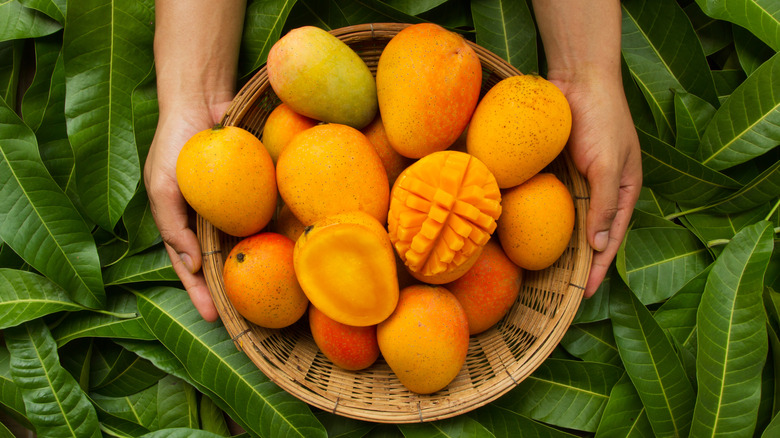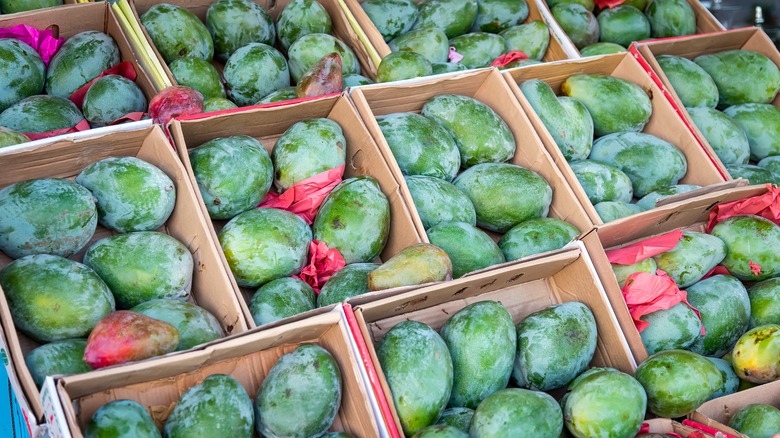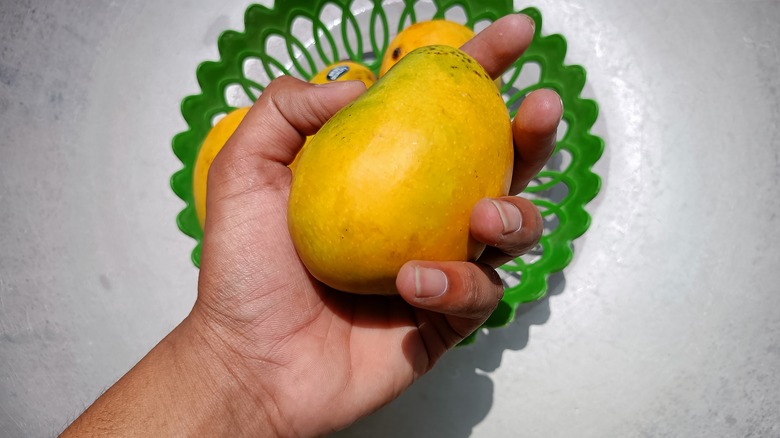Why You Shouldn't Rely On Color To Tell If A Mango Is Ripe
Though mangoes originated in India and Southeast Asia thousands of years ago, the fruit didn't become popular in the U.S. until the 19th century, per The Mango Factory). Today, U.S. farmers in Florida, California, Hawaii, and Puerto Rico grow mangoes, but most of the mangoes Americans eat are still grown in other countries close to the equator where the climate is ideal for mango production.
Mangoes are used in all kinds of dishes and cuisines, either as the star of the show or as a sweet accompaniment. Popular dishes include mango chutneys, smoothies, curries, salads, tacos, sushi, mango hot sauce, and more — sometimes the hardest part of cooking with the fruit is cutting the mango properly.
If you're a fan of mangoes, the good news is that numerous varieties exist in the U.S. However, the problem lies in how to tell if your specific variety of mango is ripe. With numerous types of mangoes available, there's no correct color for mangoes in general as ripe fruit can range from green to yellow and red (via Blue Flame Kitchen). Fortunately, there are other ways to figure out when a mango is at its peak.
The different varieties of mangoes
Depending on the time of year and where you live, you're apt to come across several mango varieties, including Honey, Francis, Haden, Keitt, Kent, and Tommy Atkins (via Mango.org). Each of these varieties comes in a different size, shape, color, and boasts a unique flavor. Whether you're making a spicy mango and shrimp salad recipe or just serving slices up with tajín, understanding which type of mango you are using can help you know if the fruit is ripe.
For example, the Tommy Atkins variety is one of the most popular types of mangoes that you'll find in U.S. supermarkets, per Specialty Produce. This mango is reddish-orange in color, oftentimes with a touch of green. It's also large, firm, fibrous, and mild in flavor.
On the other hand, the Kent variety of mango looks way different than the Tommy Atkins. According to CAPCO Farms, it's also a large, oval-shaped mango, the Kent is mostly green and is known for its sweet taste and soft flesh. If you were judging mangoes solely by color, you might think a green Kent mango is under-ripe when it's actually at peak readiness.
The best way to tell a mango's ripeness
Some varieties of mangoes will change color when they're ripening, but that's not always the case (via Blue Flame Kitchen). The next time you're mango shopping, read the sticker on your mango and see if you can tell what type of mango it is. From there, you can even start learning which mangoes are available throughout the seasons and what they should look like when ripe so you can pick the perfect produce every time.
If keeping track of different mango varieties and their appearances isn't in the cards, Mango.org shares that it's best practice to use touch to determine a mango's ripeness. Use your hands to squeeze the mango gently and determine if it's slightly soft. Generally, the softer the mango, the riper it is. Some mangoes even emit a sweet scent when they're ripe, so if you can't tell immediately by touch, your olfactory senses might be a good alternative.
The good news is that even an unripe mango can be enjoyed. Some people buy slightly unripe mangoes and let them ripen at home, while others incorporate tart, unripe mangoes into more savory dishes or even enjoy them as crisp snacks.


